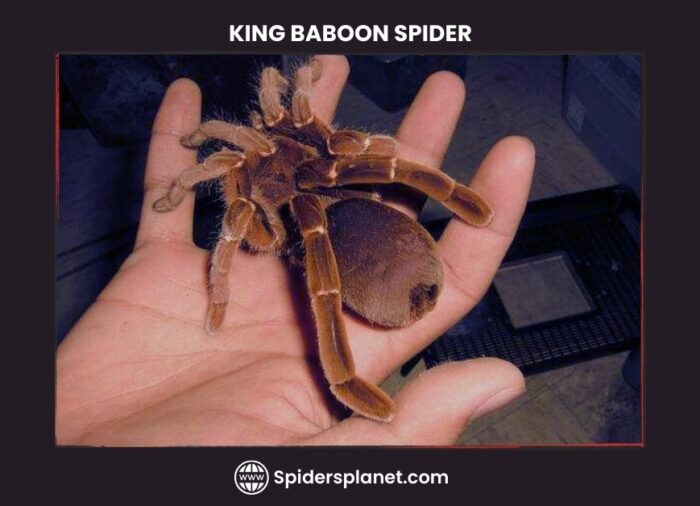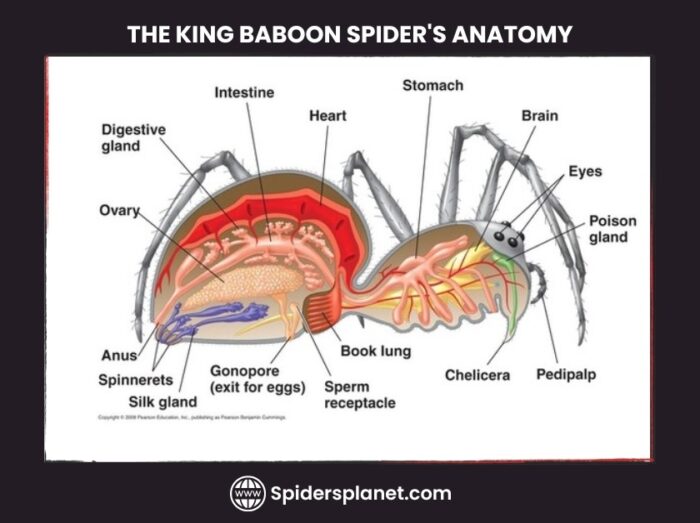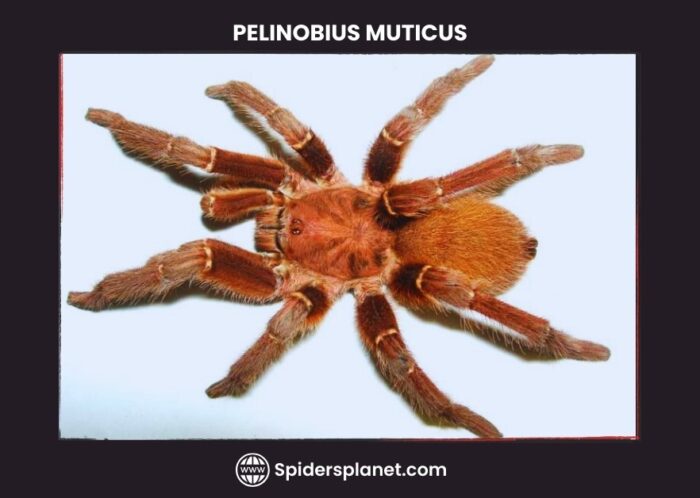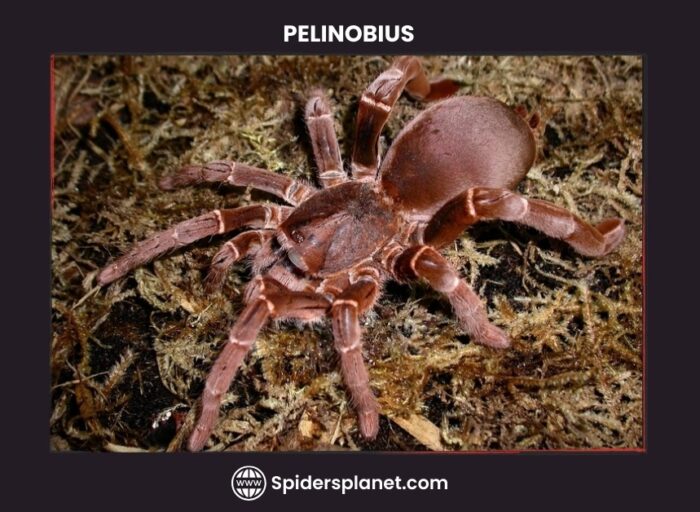In the depths beneath the hot East African savannas, a powerful ruler resides—the King baboon spider (Pelinobius muticus).
With an impressive eight-inch leg span, this spider commands respect for its size and venomous bite. Unlike its web-building relatives, this monarch prefers an underground domain, overseeing a complex burrow that serves as both a fortress and hunting ground.
Despite its fearsome reputation, the king baboon is more than just a stealthy predator.
First collected in Kenya in 1899, known for their aggressiveness, they are considered potentially dangerous, much like other baboon spiders.
Despite this, they have become a popular choice in the hobby, and people can sometimes find captive-produced spiderlings for enthusiasts to raise.
In this article, you will get comprehensive details about the majestic arachnids of Africa. Discover its name, appearance, habitat, behavior, diet, and lifecycle, and gain insights into the secrets that highlight its significance as a crucial component of the African ecosystem.
From its venomous bite to its role in the ecosystem, this exploration aims to provide a thorough understanding of this tiny spider and its unique attributes. Keep reading….!
Quick Facts About King Baboon Spider:
Here are some quick key interesting facts about the king baboon tarantula:
- With a leg span of up to 8 inches, the Baboon tarantula is one of Africa’s largest spiders.
- Preferring a subterranean lifestyle, it digs burrows up to 2 feet deep, providing shelter and a strategic hunting ground.
- Emit a hissing sound when threatened, showcasing impressive defense mechanisms.
- Despite its name, it is a carnivorous predator, using venom to subdue prey like insects, rodents, and lizards.
- Slow growing, it reaches maturity after years and can live up to 20 years among the longest-lived spiders.
- Playing a crucial role in insect control and serving as prey, it maintains a healthy balance in the savanna ecosystem.

King Baboon Spider Description:
Scientific Name, Specie, and Family:
King baboon spider having scientific name Citharischius crawshayi, is an arachnid classified under the Animalia kingdom, Theraphosidae family, and Pelinobius genus.
Its binomial name is Pelinobius muticus, with the species name “muticus”. This spider is also known as King Baboon Tarantula commonly in Africa.
Body:
The Muticus tarantula is a big, hairy tarantula with a velvety burnt orange color all over its body. It has extra big back legs like other baboon spiders and large, shiny black fangs that it’s not afraid to use.
The males are hairy and slim, and they don’t have special hooks on their legs to help with breeding.
Anatomy:

The king baboon spider’s anatomy includes:
- A dark brown carapace protects the head and thorax.
- Powerful venom-injecting fangs.
- Leg-like pedipalps for various functions.
The strong legs aid in digging, with the first two pairs used for a unique defense hiss. The thorax features a sternum guarding vital organs and book lungs for respiration.
The soft-bodied abdomen (opisthosoma) houses digestive, reproductive, and circulatory systems, while spinnerets produce silk for burrow lining and egg wrapping. Urticating hairs on the abdomen serve as a defense mechanism, irritating predators.
The King Baboon Tarantula has a nasty bite and eats crickets and insects. King baboons lack teeth but use their fangs to inject venom into prey.
The tarantula drinks up the liquid, and it goes through the stomach and intestines, breaking into small pieces. These pieces pass into the bloodstream, spreading nutrients throughout the body. The waste is formed into a ball and then expelled through the anus.
Appearance:
Size:
It is one of the biggest spiders in Africa, with legs that can reach up to 8 inches (20 centimeters).
On average, they measure around 5.5 to 6 inches (14 to 15 cm), but a fully grown female can be even larger, possibly exceeding 7.8 inches (20 cm). Mature males are generally smaller than females.
Its impressive size serves two important roles: it helps the spider catch its prey and scares away things that might be a danger to it.
Color:
The African baboon spider, with its rusty brown to orange hues, blends perfectly into the savanna landscape, using its colors as camouflage to wait for unsuspecting prey.
Its coloration helps it blend perfectly with its surroundings, making it tricky for both prey to notice and predators to find.
Habitat:
The king baboon spider resides in the dry Acacia scrublands of central-eastern Africa, including Kenya, Uganda, and Tanzania.
This specific habitat suits the spider due to its dry climate, sandy soil for easy burrow digging, and the abundance of insects like beetles and crickets, which serve as its main food source.
The spider’s rusty brown to orange colors provide effective camouflage in the savanna landscape, where it patiently awaits unsuspecting prey.
Notably, these spiders are often found near the base of acacia trees, benefiting from shade and attracting insects for hunting.
Unlike other spiders that build webs, the King Baboon Tarantula likes to live underground. It is really good at digging, using its strong back legs to make deep and intricate burrows that go several feet down.
These burrows keep it safe from the hot sun and other animals looking for a meal. Plus, they make excellent hiding spots for catching prey by surprise.
Behavior:
King Baboon Spiders are known for being very aggressive, and it is best to keep them in their own homes. Even minor disruptions can trigger a defensive response in African King Baboon Spider.
Despite being strong and tough, the Baboon tarantula usually tries to stay away from fights. But if it feels in danger, it has some cool tricks to protect itself.
It can stand up on its back legs, showing off its big fangs and making itself look scarier. Plus, it has a special skill called stridulation.
It rubs its legs together to make a hissing sound, kind of like a warning to scare away anything that might be a threat.
Lifespan:
The average lifespan of the king baboon spider, with females typically living longer than males. For females, the average lifespan is in the range of 20 to 25 years, while males have a shorter lifespan, ranging from 10 to 15 years.
This difference in lifespan between males and females is a common pattern in many spider species.
What They Like to Eat or Hunt?
Even though it is called the king baboon spider, it is not a plant eater; rather, it actually loves to eat meat. This spider’s diet includes different bugs like beetles, crickets, grasshoppers, Tenebrio larvae, and locusts.

But it does not stop there – it is brave enough to go after bigger meals like small rodents and lizards. With its strong legs and a bite full of venom, the King Baboon Tarantula is a skilled predator in the savanna, making sure it stays at the top of the food chain.
Predators:
Birds, reptiles like snakes and lizards, mammals like Mongoose, and other opportunistic feeders, such as rodents, amphibians, and even other spiders, are predators for this African king baboon.
Mating:
Reproducing the King Baboon Spider poses unique challenges. Mature males, smaller and hairier than females, lack tibial hooks crucial for breeding.
Inspiring them to breed is difficult, and females are aggressive towards males. To initiate mating, introduce the male cautiously after he creates a sperm web.
Without interest, the female may attack or eat him, requiring protection.
After mating, feed the female more frequently. Egg sac production occurs within one to eight weeks, suspended in a web hammock for five to eight weeks.
Once spiderlings emerge, they should be separated to prevent cannibalism. Plastic vials with deep substrate and a touch of humidity aid their growth.
Lifecycle:
The king baboon spider’s life starts with the egg stage, where the female protects the egg sac for 4 to 8 weeks until hatching.
Tiny spiderlings undergoing their first molt inside the sac. In the juvenile stage, they leave the sac, gradually growing through multiple molts while hunting for small insects.
The adult stage sees them reach maturity, with large individuals having a leg span of up to 8 inches. Adults are solitary, nocturnal predators living in caves, with females living up to 20 years and males for 10-15 years.
Mating, courtship dances, and reproduction occur during the rainy season, with males dying shortly after mating.
Throughout their existence, these spiders experience molting, a process where they shed their exoskeleton to facilitate growth.
This intricate life cycle underscores their fascinating behaviors and adaptations in the challenging savanna environment.

Bite and Venom:
While the baboon spider carries venom, it poses no lethal threat to humans. The venom is mainly used to catch small prey like insects.
It has some substances that affect the nervous system, causing pain and swelling at the bite spot. The venom also has molecules that make it stronger and help it spread.
Additionally, some proteins break down tissues to assist in digesting prey.
Symptoms of the Bite:
Effects of a bite can include:
- Intense pain lasting for a few hours to a day,
- Redness,
- Swelling
- Muscle cramps
- Severe cases might lead to nausea and vomiting
- Make you itchy for about five days.
Treatment and Preventive Measures:
All these symptoms, as mentioned above, are rare. Although the bite is not dangerous, it can be very painful, and you should get medical help if the symptoms are severe.
Some facts about the venom include its non-lethality due to the small amount injected, variability depending on the spider’s age and diet, and no specific antidote, with treatment focusing on pain management and wound care.
- Remember, it is safest not to handle baboon spiders, and if bitten, seek medical attention.
- To safely move the Pelinobius muticus between enclosures for cleaning, maintenance, or breeding attempts, it is recommended to use a paintbrush or another tool.
- This helps in gently guiding and controlling the spider without causing harm or stress. Employing tools facilitates a gentle and controlled transfer, prioritizing the safety of both the spider and the handler.
Enclosure and Care:
In the wild, you can find the Pelinobius muticus living in deep caves near rocks or tree bases. In a pet home, it is recommended to keep them in a 15 to 20-gallon tank with a secure lid.
Fill the enclosure with about 10 inches of compacted sand, peat moss, or potting soil so they can dig and make a burrow, which they really like.
To keep them comfortable, make sure the temperature stays between 78° to 82°F, and maintain a humidity level of 75% to 85%.
This helps them feel at home since they naturally prefer warm and humid conditions.
Role in Ecosystem:
Even though the Pelinobius muticus is strong, it is crucial to understand that it has an important job in the ecosystem.
Eating insects helps keep their numbers in check and makes sure everything in the savanna stays in balance.
So, instead of being scared, we should appreciate and respect this amazing creature for the role it plays in nature.
Baboon Spider vs Rain Spider:
Here is a table summarizing the key differences:
| Feature | Baboon Spider | Rain Spider |
| Size | Larger | Smaller |
| Habitat | Dry savannas | Forests and grasslands |
| Lifestyle | Solitary, burrowing | Social, often found in groups |
| Diet | Insectivorous, small rodents, lizards | Insectivorous |
| Venom | More potent | Less potent |
| Appearance | Rusty brown to orange | Black or brown with lighter markings |
Baboon Spider vs Tarantula:
Here is a table summarizing the key differences:
| Feature | Baboon Spider | Tarantula |
| Habitat | Dry savannas of East Africa | Diverse, found in tropical and subtropical regions worldwide |
| Lifestyle | Primarily burrowing | Terrestrial and arboreal depending on species |
| Social Behavior | Solitary | Solitary, some species exhibit communal behavior |
| Venom | Moderately potent, not considered dangerous to humans | Potency varies, most not lethal to humans, some have painful bites |
| Size | Potency varies, most not lethal to humans, some have painful bites | Diverse, ranging from small to large, Goliath Birdeater can have a leg span exceeding 11 inches (28 cm) |
| Defense Mechanisms | Hissing, rearing up, stridulation (rubbing legs together) | Barbed hairs, kicking hairs, biting, fleeing |
| Diet | Insectivores, some prey on small rodents and lizards | Insectivores, some eat worms, spiders, rodents, lizards, and even birds |
| Lifespan | Up to 20 years | Females can live for decades, males have shorter lifespans |
FAQs:
Can we keep King baboon spiders as pets?
African baboon spiders are sought after by collectors, but they are known for being very defensive and are not recommended for beginners, mainly because they lack urticating hair. While their venom is potent, none are considered deadly to humans.
Is a baboon spider poisonous?
Yes, the baboon spider is poisonous. However, its venom is not considered dangerous to humans. Bites can cause pain and swelling but typically subside within a few hours.
Are baboon spiders aggressive?
Baboon spiders are generally not aggressive, preferring solitude. While they avoid conflict, they’ll defend themselves when threatened.
How do King baboon spiders protect themselves?
Pelinobius muticus arachnids defend themselves with camouflage, burrows for shelter, non-lethal venom, barbed hairs, hissing sounds, and their formidable size.
Final Thoughts:
The King Baboon Spider stands as a species of special concern due to habitat loss, prompting vital conservation efforts.
Beyond its fearsome reputation, this remarkable spider symbolizes strength and resilience, showcasing nature’s marvels. Understanding and protecting these creatures contribute to the intricate web of life.
The king baboon’s significance in the African savanna ecosystem, from its evil predation to its role in maintaining balance, emphasizes the need for respect and appreciation.
As a species vulnerable to environmental changes, conservation initiatives play a pivotal role in safeguarding the Baboon tarantula and preserving its unique presence for future generations.




Leave a Reply